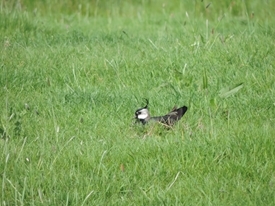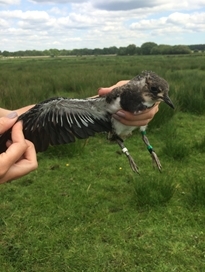Due in part to a very wet Spring, the Game & Wildlife Conservation Trust (GWCT) has reported a rise in the number of lapwing chicks that fledged across its field sites in the Avon Valley, Hampshire. As lapwing is a species of conservation concern, this is a very positive result for the local population.
 “Spring this year was exceptionally wet in the Avon Valley;” explains Lizzie Grayshon, GWCT Waders for Real Project Ecologist, “with the river breaking its banks several times over the spring months. These high water levels can have mixed effects on breeding waders. During the nesting period they are particularly vulnerable to rising water levels, as they nest on the ground with little nesting material. However, if the eggs survive long enough to hatch, the chicks can benefit from the damp conditions, as the ditches and scrapes stay wet for much longer into the spring.
“Spring this year was exceptionally wet in the Avon Valley;” explains Lizzie Grayshon, GWCT Waders for Real Project Ecologist, “with the river breaking its banks several times over the spring months. These high water levels can have mixed effects on breeding waders. During the nesting period they are particularly vulnerable to rising water levels, as they nest on the ground with little nesting material. However, if the eggs survive long enough to hatch, the chicks can benefit from the damp conditions, as the ditches and scrapes stay wet for much longer into the spring.
This year there were around 80 pairs of lapwing across the field sites in the Avon Valley, an increase of 20 pairs from 2015. The majority of the pairs nested on two of the four hotspot sites. These two sites offer large grazed fields with optimum sward height for nesting and re-nesting opportunities.
It is known that for a lapwing population to remain stable, productivity (number of chicks fledged per pair per year) needs to be at 0.7. Unfortunately, in most years the lapwing do not reach this level in the Avon Valley, and consequently their numbers have been declining.
This year, the productivity across the whole of the Avon Valley reached 0.6 chicks per pair. However, on the two hot-spot sites where we had 37 pairs of lapwing the productivity reached 1.1, which is very promising.
 Lizzie concludes, “We believe that the success this year has come from a number of contributing factors, including an increased management effort at the sites, including an altered grazing regime and more targeted predator control. Also, the higher water levels allowed the ditches and scrapes to remain wet for a longer period of time, creating ideal foraging areas with increased insect abundance.”
Lizzie concludes, “We believe that the success this year has come from a number of contributing factors, including an increased management effort at the sites, including an altered grazing regime and more targeted predator control. Also, the higher water levels allowed the ditches and scrapes to remain wet for a longer period of time, creating ideal foraging areas with increased insect abundance.”
The GWCT has monitored breeding waders in the Avon Valley for over 20 years and recording of lapwing breeding success over the last eight years has shown that numbers of chicks fledging are too low to support a stable breeding population.
The EU LIFE-funded 'Waders for Real’ project was launched in 2015 with the aim of reversing the decline of breeding waders in the Avon Valley. The GWCT and students from Sparsholt College have been working with farmers and landowners to improve habitat for these birds and reduce predation of nests and chicks by crows and foxes.
For more information on the LIFE Waders for Real project, see gwct.org.uk/wadersforreal
Please support our wader work in the Avon Valley
Notes to editors
The Game & Wildlife Conservation Trust – providing research-led conservation for a thriving countryside. The GWCT is an independent wildlife conservation charity which has carried out scientific research into Britain’s game and wildlife since the 1930s. We advise farmers and landowners on improving wildlife habitats. We employ more than 60 post-doctoral scientists and other research staff with expertise in areas such as birds, insects, mammals, farming, fish and statistics. We undertake our own research as well as projects funded by contract and grant-aid from government and private bodies.
For information, contact:
Eleanor Williams
Telephone: 07592 025476
Email: press@gwct.org.uk